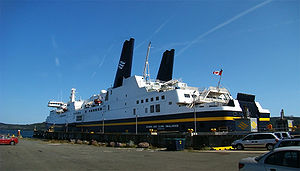MV Joseph and Clara Smallwood
| |
This article does not cite any references or sources. Please help improve this article by adding citations to reliable sources. Unsourced material may be challenged and removed. (June 2008) |
 Docking in Argentia, Newfoundland and Labrador | |
| Career | |
|---|---|
| Name: | MV Joseph and Clara Smallwood |
| Owner: | Government of Canada |
| Operator: | Marine Atlantic |
| Port of registry: |
|
| Route: |
Channel-Port aux Basques—North Sydney (fall, winter, spring) Argentia-North Sydney (summer) |
| Ordered: | 1987 |
| Builder: | MIL-Davie Shipbuilding |
| Laid down: | 1987 |
| Launched: | 1989 |
| Christened: | 1989 |
| Completed: | 1989 |
| Maiden voyage: | 1989 |
| In service: | 1989 |
| Identification: | IMO number: 8604797 |
| Status: | In service |
| General characteristics (as built) | |
| Class and type: | Gulfspan class icebreaking ropax ferry |
| Tonnage: | 27615 GT (gross tonnage) |
| Length: | 172.76 m (567 ft) |
| Beam: | 24.99 m (82 ft) |
| Draught: | 12.19 m (40 ft 0 in) |
| Ramps: | shore-based bi-level ramps |
| Ice class: | Lloyd's 100A1, Northern Baltic 1A Super |
| Installed power: |
4 × MaK 8 cylinder diesels combined 20600 kW |
| Propulsion: |
2 propellers 2 bow thrusters 2 stern thrusters |
| Speed: |
22 kn (40.74 km/h) (maximum) 15 kn (27.78 km/h) (service) |
| Capacity: |
1200 passengers 370 cars, 77 trucks 1,800 m (5,906 ft) lane metres |
| Crew: | 106 (summer), 68 (winter) |
MV Joseph and Clara Smallwood is a Marine Atlantic passenger/vehicle ferry which operates between Newfoundland and Cape Breton Island in eastern Canada. The super ferry is expected to continue operating until sometime 2011, after which it will be retired. The name is after former Newfoundland and Labrador politician Joseph R. Smallwood and his wife Clara.
Concept and construction
Entering service in 1989, she was built by Fortis Incorporated in Lauzon, Quebec, and is specifically designed for the 280 nautical mile (520 km) seasonal route across the Cabot Strait between North Sydney, Nova Scotia and Argentia, Newfoundland and Labrador. A roll-on, roll-off design with a bow visor, the Joseph and Clara Smallwood has 2 vehicle decks and 5 decks above, the main passenger deck being Deck 5. She measures 179 metres in overall length and 25 metres in breadth, weighing 27,614 tons. Her capacity includes 1,200 passengers and 370 automobiles or 77 tractor trailers. She has up to 106 crewmembers.
Her sister ship, MV Caribou's design had been commissioned by CN Marine in the early 1980s and was the culmination of years of research into effective icebreaking ship designs. The resulting hull design which MV Caribou and MV Joseph and Clara Smallwood were built to is called "Gulfspan", named in part after the Gulf of St. Lawrence. The "Gulfspan" hull is unique among Canadian icebreakers in that the ship slices through sea ice, rather than using its weight to ride up onto and crushing the ice underneath. This design permits the sister ships to maintain close to regular operating speed.
Service history
After MV Joseph and Clara Smallwood replaced MV Ambrose Shea in 1989, the North Sydney-Argentia crossing was reduced from 18 hours to a 14 hour schedule. During the northern hemisphere fall, winter and spring seasons, MV Joseph and Clara Smallwood joins her sister ship Caribou, along with MV Leif Ericson on Marine Atlantic's 96 nautical mile (178 km) primary route between North Sydney, NS and Channel-Port aux Basques, NL. On July 1, an engine system failed on the Joseph and Clara Smallwood, making the summer crossing from Argentia, NL-North Sydney, NS 17 hours.[1]
The Joseph and Clara Smallwood will be retired in 2011, after the MV Stena Trader & MV Stena Traveller, two chartered vessels from Stena Lines, are put into service.
